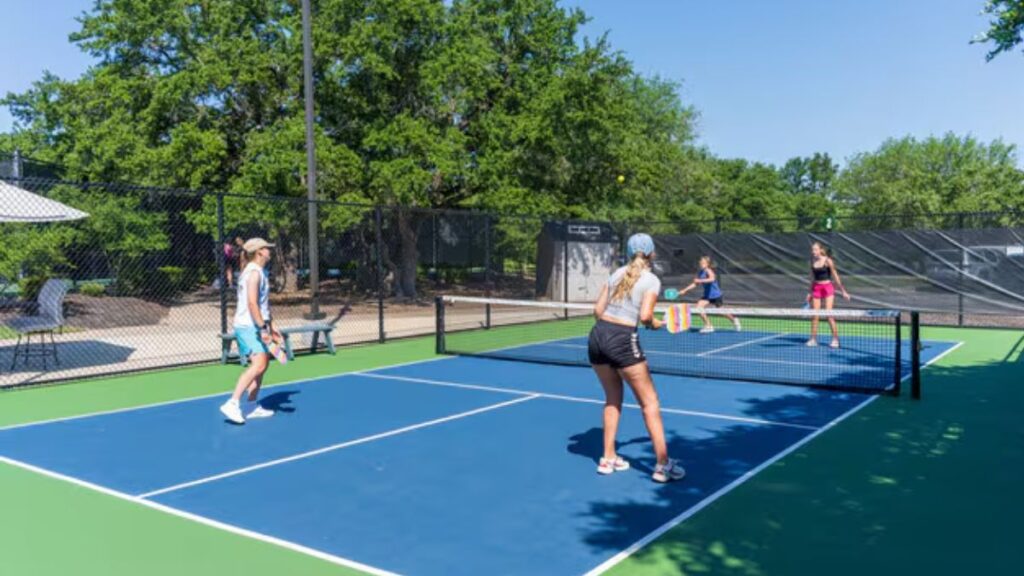Pickleball is one of the fastest-growing sports in the U.S., combining tennis, badminton, and ping pong into a fun, accessible game. As it gains popularity, more homeowners, clubs, and recreational facilities are building custom pickleball courts. However, creating a court isn’t just about laying a surface and marking lines. A good court should focus on playability, durability, and comfort. For property owners, the right court surfacing enhances both the environment and the playing experience.
Start with Proper Court Dimensions
A regulation pickleball court is 20 feet wide and 44 feet long, suitable for singles and doubles play. These dimensions are essential for fair gameplay. When planning a court, include buffer zones: at least 10 feet behind each baseline and 5 feet on each side to give players space to move safely. If possible, add extra room around the perimeter, especially for multiple courts. This improves player comfort and safety during fast-paced matches.
Choose the Right Orientation
The orientation of an outdoor court affects its usability. A north-south alignment is best, as it minimizes sun glare during morning and late afternoon matches, reducing discomfort and improving visibility. For indoor courts, proper lighting is key. High-efficiency lighting ensures consistent visibility and minimizes shadows, making it ideal for extended play in community centers or private clubs.
Surface Selection Matters
Choosing the right surface is key to court design. The material needs the right balance of grip and smoothness to prevent slipping and ensure consistent ball bounce. Cushioned acrylic coatings are popular for reducing joint strain during long matches. In dry climates, with extreme temperatures and UV exposure, court surfaces must withstand freezing winters and occasional moisture without cracking or fading. Durable, high-quality surfacing extends the court’s lifespan and reduces maintenance costs. For pickleball court surfacing in Utah, slip-resistant, thermal-tolerant materials are a top choice, built to endure extreme summer heat and winter freeze-thaw cycles.
Add Effective Drainage Solutions
Proper drainage is key to maintaining a high-quality court. Standing water not only delays play but also causes surface damage like cracks and erosion. To ensure performance and safety, courts need slope grading and effective water runoff systems. In areas with heavy rain or snowmelt, good drainage protects the court and ensures year-round use. A slight 1% slope allows water to flow off naturally, keeping your court in great condition.
Install Quality Fencing and Windscreens
A pickleball court without proper fencing can lead to lost balls and safety issues. A perimeter fence keeps balls in play, defines boundaries, and ensures spectator safety while maintaining gameplay focus. Fences should be at least 10 feet high and made from durable, rust-resistant materials. In windy areas, adding windscreen panels can reduce gust impact, block distractions, and give the court a polished, professional look.
Think About Color and Visibility
Enhancing color contrast between a court’s main play area and its out-of-bounds zones can significantly improve players’ focus and reaction times. A popular solution is two-toned surfacing, with one color for the interior and a contrasting shade for the perimeter. In warmer climates, lighter colors are especially beneficial as they minimize heat absorption. Additionally, professionally applied, high-contrast lines are essential for helping players track ball placement and court boundaries with precision during fast-paced matches.
Amenities That Enhance Player Comfort
Beyond the playing surface, consider what features will improve the overall experience:
- Shaded seating areas for players and spectators
- Water stations to stay hydrated
- Storage areas for paddles and balls
- Court lighting for evening matches
Including these small details shows a commitment to player satisfaction and can elevate a court from basic to premium.
Conclusion
Creating an exceptional pickleball court goes far beyond simply marking boundaries and installing surface materials. Every element—drainage, fencing, color schemes, and surfacing—plays a vital role in enhancing playability, comfort, and durability. To deliver a court that players can rely on, property owners should prioritize performance-focused materials and thoughtful design. By doing so, they ensure a safe, enjoyable, and high-quality playing experience for athletes of all skill levels, all year long.







